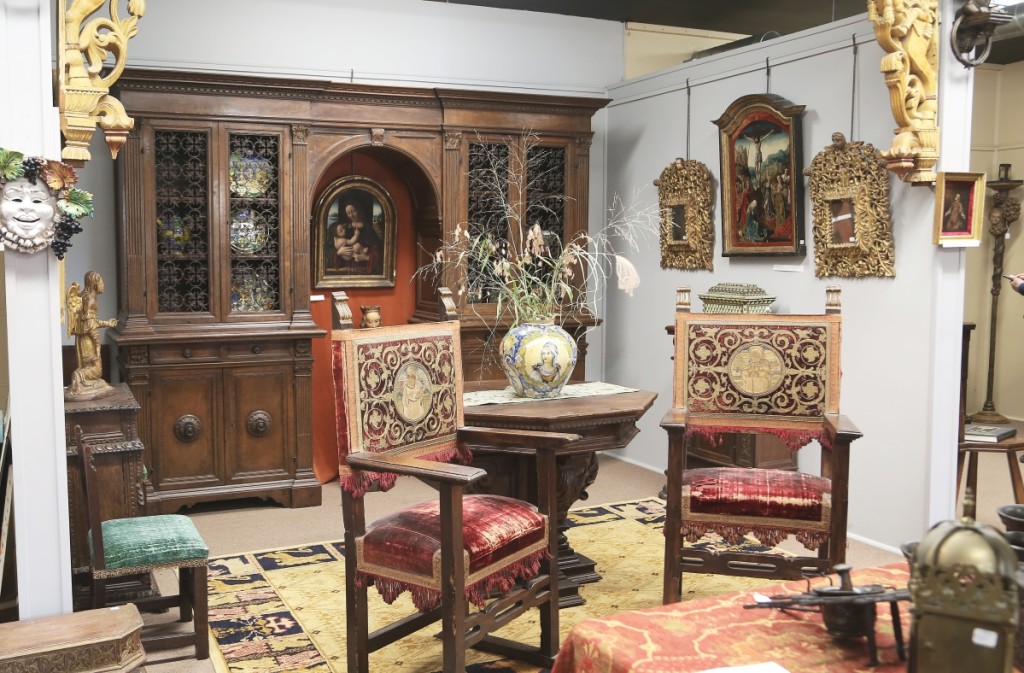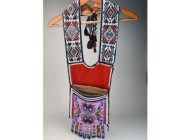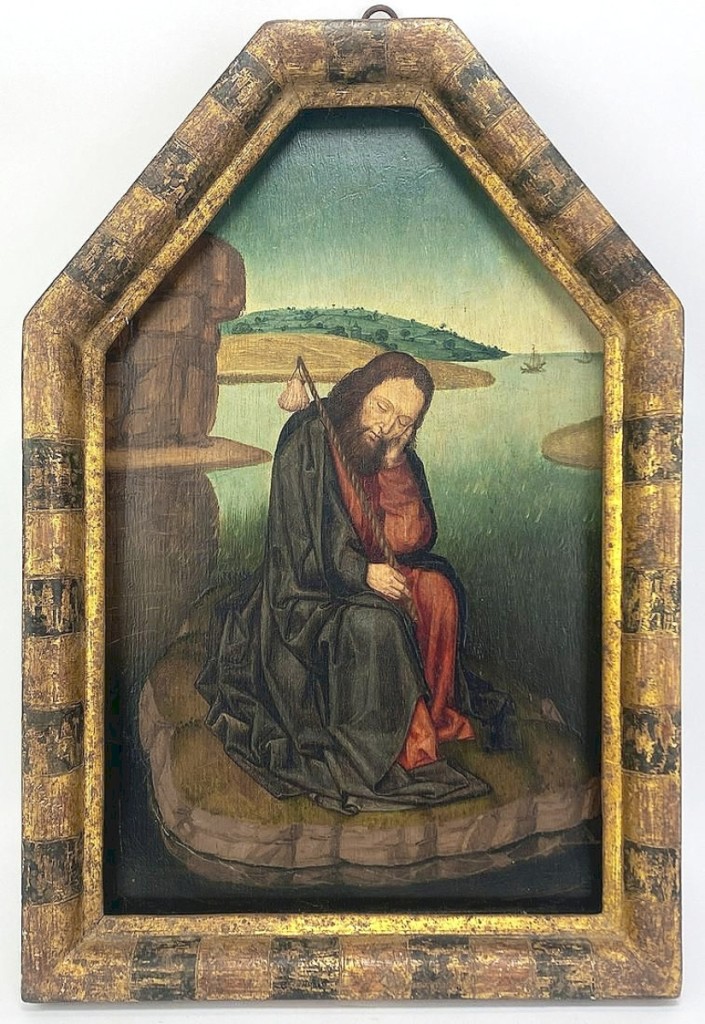
The highest priced item in the sale, earning $51,240, was this small Flemish painting of Saint James. Its provenance included the famed Seligman collection.
Review by Rick Russack, Onsite Photos by Rick Russack & Z.G. Burnett, Additional Photos Courtesy CRN
CAMBRIDGE, MASS. – It was a single-owner sale at CRN on April 10, and if any of the 330 lots offered were made in the United States, it would have been hard to find them. Carl Nordblom and partner Karin Phillips, both well known for selling Americana as well as European and Twentieth Century decorative arts, had the opportunity to put on a sale with completely different material. It was a carefully selected collection of Renaissance-era material – mostly Italian and Spanish with some French and items from other parts of Europe as well. Many of the items dated from the Fifteenth, Sixteenth and Seventeenth Centuries and the collection also included Spanish colonial objects as well as Hispano-Moresque objects from the same time period. Nearly all was in fine condition, and came from the collection of Peter and Linda MacNeilage, a Texas couple who had started collecting in the 1970s. They had bought from the finest dealers and auction houses, including CRN. Estimates were conservative, and buyers from a number of countries participated. More than a dozen items brought five-figure prices. There were about 50 bidders in the room, several phone lines were active as were internet platforms, and numerous absentee bids were executed.
Offerings included numerous varguenos on stands, early carved bone caskets, Flemish and other paintings of the period, carved limestone items, carved marbles, numerous carved figures of saints, early majolica, silvered reliquaries, Charles II lantern clocks, Spanish colonial silver, tapestries and other textiles, early brass and bronze items and much more.
Peter MacNeilage and two of his adult children were at the sale and discussed the collection. Peter said, “It grew and our interest broadened from Linda’s first interest in ethnic and pre-Columbian cultures, which developed after she studied with Margaret Mead at Columbia University.
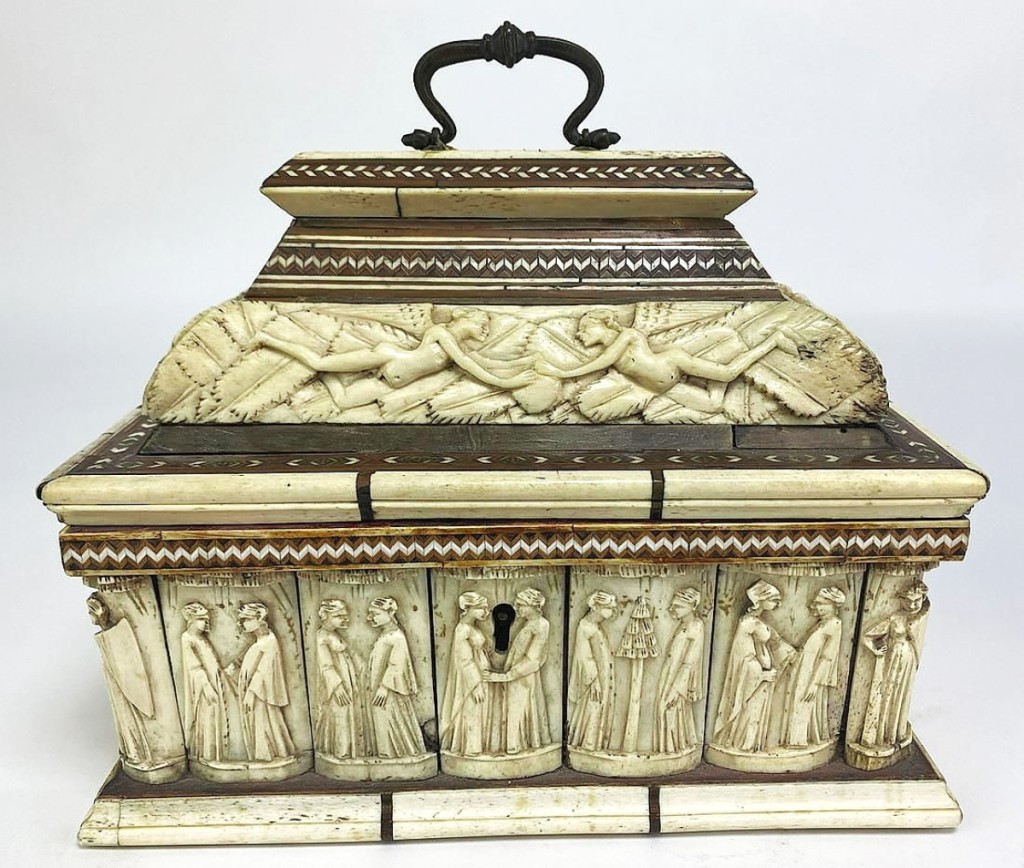
There were two of these carved bone and inlaid wedding caskets. Both were from the Italian workshop of Luigi Pelletieri Baldassare Embriachi and both were made in the early years of the Fifteenth Century. This one sold for $15,680. The second one brought a bit less, $14,640.
“In the beginning, we bought from just a couple of dealers who were knowledgeable and who we trusted, and they were very helpful to us. We also bought from Sotheby’s and Christie’s, which were at the time each conducting two sales a year with the material we liked. They dispersed some major collections, and we had the opportunity to get some very fine things. We traveled to Europe to visit museums and sites, and although we did some buying there, most was bought in this country. Our home in Austin was furnished with the Renaissance objects we loved. We were both passionate about the material, and Linda researched each item and kept detailed notes on everything. We developed a large collection of books and other reference material. She had a particular interest in the early textiles. Our children grew up surrounded by the collections. It’s interesting to see which items are doing well at this sale. Some of the furniture is selling for less than we paid, but that’s more than offset by things like the Flemish paintings, which did really well.”
Paul MacNeilage, their son, said, “We were always going to museums with mom and dad, especially the Cloisters and the Met in New York.” Both he and sister Shannon said new additions to the collections were the subjects of dinner table conversations, as were the background stories associated with the objects.
Two Sixteenth Century Flemish paintings, one of Saint James and the other of the Madonna and Child, brought two of the three highest prices of the day. Saint James, not large – just 13½ by 8½ inches on panel – was part of the 1990 Christie’s sale of the Seligman collection. Members of the Seligman family were among the world’s leading dealers in Renaissance art, going back to 1880, and with a most impressive client list. The painting of Saint James earned $51,240. The Madonna and Child, cataloged as “by a follower of Leonardi Da Vinci” and possibly in its original frame, brought $21,960.
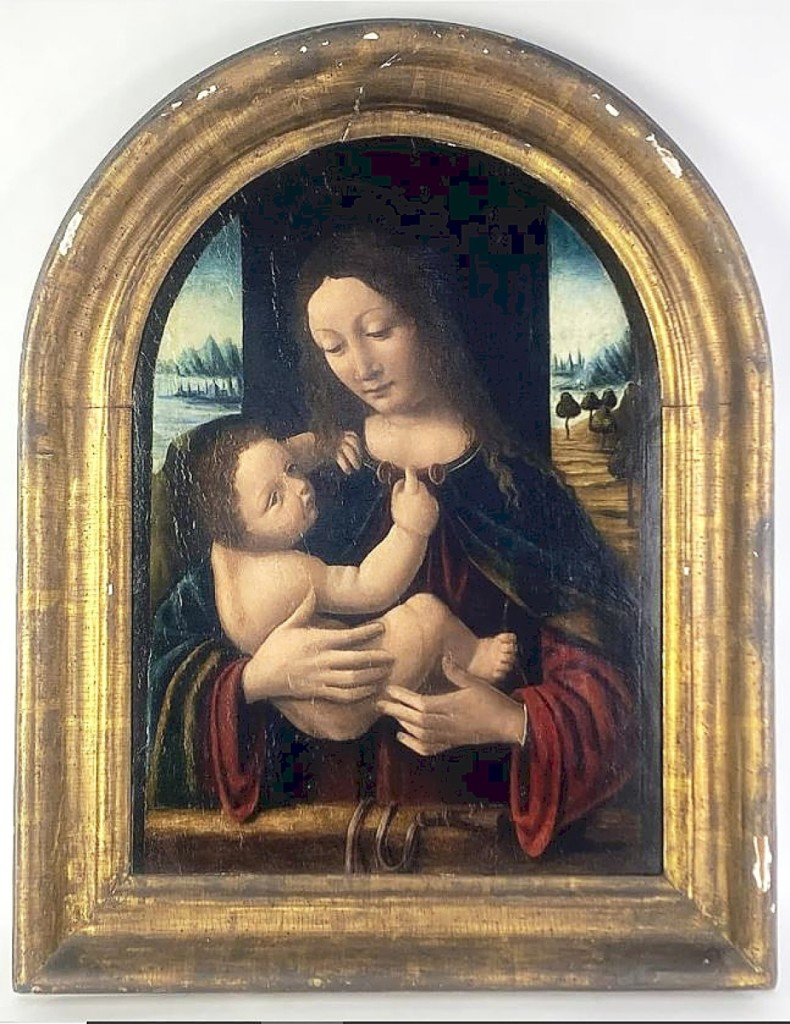
Another early Flemish painting that did well was this Madonna and Child, cataloged as “by a follower of Leonardi Da Vinci” and possibly in its original frame. It sold for $21,960. As with other paintings in the sale, this one was examined under black light, and those images were included in online descriptions.
How often do you see Fifteenth and Sixteenth Century varguenos? This sale had more than half a dozen. A walnut Hispano-Moresque example with a fall-front lid that opened to reveal an interior fitted with 13 parcel-gilt and bone inlaid drawers sold for $11,590. It was mounted on its original taquillon base, with four drawers, and wrought iron mounts and handles. Four others, on stands rather than taquillons, each sold for $5,795. At least two, possibly all four, sold to an internet bidder.
One could also ask how often do you see Fifteenth and Sixteenth Century wedding caskets with overall carved and inlaid bone panels? There were two in this collection from the Fifteenth Century workshop of Luigi Pelletieri Baldassare Embriachi. Both had hinged lids with bone and horn inlay above applied panels of angel-like couples flying among foliage. The body of each had applied vertical carved bone panels of couples on all sides. They were exquisite and in fine condition. One sold for $15,860, and the other brought $14,640. The Metropolitan Museum of Art has two panels from this workshop, with at least one on display, and dates them as circa 1400-09. The collection had other caskets in both bone and iron.
There were carved figures of saints, some of wood, some of bone. A German 39-inch-tall, Fifteenth/Sixteenth Century polychromed carving of the Madonna and Child earned $9,150. A 34-inch-tall carved and polychromed figure of Saint Catherine, holding a book and a sword, finished at $8,540. According to a Google search, she is also known as Saint Catherine of Alexandria, and her legend relates that she was murdered at age 18, and Joan of Arc identified her as one of the saints who appeared and counseled her. A 38-inch-tall polychromed French gothic figure of Saint Ursula, holding an arrow and a book, finished at $5,185. One of the legends concerning Ursula is that she was killed, along with 11,000 of her virgins, by the Huns in 383 CE. A Sixteenth/Seventeenth Century figure of Saint Stephen, carved of bone, also realized $5,185. Legend says that he was appointed by the Seven Apostles to distribute food to the poor and is considered to be the first martyr. There were numerous other carved figures.
Linda MacNeilage had a special attraction to medieval textiles. A room-sized Kashan hunt rug with numerous figures of animals being hunted by other animals reached $10,370. Her husband said that this rug was the first major purchase the couple made when they began to collect in the 1970s. There were numerous small textiles and large tapestries. A Flemish verdure wall tapestry, 10 by 8 feet, brought $9,760. It depicted dogs hunting deer in the forest, and it had a floral border. A large fragment of a Flemish verdure tapestry, showing a large bird in the forest with a dwelling in the background, realized $3,965. A group of five Eighteenth Century or earlier ecclesiastical needlework panels, each with metallic threads, brought $2,684. Again, there were several additional early textiles in the sale.
After the sale, Carl Nordblom commented, “This was really an exciting sale for Karin and me. She did most of the work. We often sell early European items, but never in this quantity and rarely of this quality. It was a very select collection and I’m glad that the consignors were pleased. We had interest from buyers in several European countries and institutions, and we had some strong prices. Furniture prices were soft, I think, because of the costs of crating and shipping these items back to Europe, but smaller items and paintings did well. I was glad to see that my favorite item, the deep marble relief carving of the Virgin and Child did so well. We cataloged it as from the Seventeenth Century, but it could have been even earlier than that. We ended up with a little over $900,000 so everyone was satisfied.”
Prices given include the buyer’s premium as stated by the auction house. For information, www.crnauctions.com or 617-661-9582.

